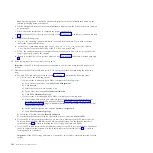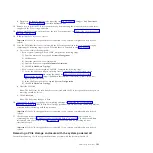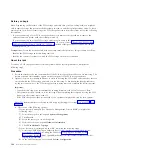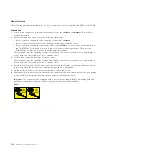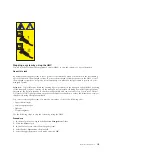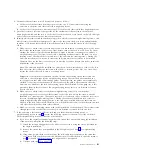
3.
Verify the existing PCIe hardware topology by completing the steps in “Verifying the PCIe hardware
topology” on page 90. All PCIe hardware topology problems that are discovered in this step must be
corrected before continuing with this procedure.
Important:
If the PCIe storage enclosure is connected to two systems, complete this step for each
system.
4.
Determine the identifier strings and link identifiers for the two I/O slots associated with the
connections to the PCIe storage enclosure being removed by completing the following steps.
Important:
If the PCIe storage enclosure is connected to two systems, complete this step for each
system. Each system will host one of the I/O slots that connect the PCIe storage enclosure.
a.
Choose one of the following options:
v
If your system is managed by a Hardware Management Console (HMC), complete the
following steps:
1)
From the navigation bar, expand
Systems Management
.
2)
Click
Servers
.
3)
Select the server you are working with.
4)
In the Tasks area, expand
Hardware Information
.
5)
Click
PCIe Hardware Topology
.
v
If your system is not managed by an HMC, complete the following steps:
1)
Access the ASMI by using an authority level of administrator or authorized service
provider. For details about using the ASMI, see Managing the Advanced System
Management Interface (http://publib.boulder.ibm.com/infocenter/systems/scope/hw/
topic/p7hby/asmi.htm).
2)
In the ASMI navigation area, expand
System Configuration
.
3)
Click
PCIe Hardware Topology
.
b.
Review the PCIe Hardware Topology data to identify all PCIe links that are associated with the
PCIe storage enclosure that you are removing. To make this identification, scan the I/O Enclosure
Port column for values that contain the feature code and serial number that you recorded in step
1 on page 98.
Note:
The I/O Enclosure Port column value looks similar to
U
xxxx
.001.
yyyyyyy
-P1-C
z
-T3
, where
xxxx
is the feature code of the PCIe storage enclosure connected by the PCIe link,
yyyyyyy
is the
serial number of the PCIe storage enclosure connected by the PCIe link, and
z
is either
1
or
2
. An
example of an actual I/O Enclosure Port column value is
UEDR1.001.6BAH004-P1-C1-T3
.
c.
For each PCIe link that you identified in step 4b, record the I/O slot identifier string from the
I/O Slots column and the link identifier from the Link ID column.
5.
For each I/O slot that you recorded in step 4c, choose one of the following options:
v
If your system is managed by an HMC and is not in the manufacturing default configuration,
continue with step 6.
v
If your system is managed by an HMC and is in the manufacturing default configuration, or if
your system is not managed by an HMC, choose one of the following options:
– If the I/O slot is assigned to a logical partition that is powered on and running the Virtual I/O
Server (VIOS) or AIX operating system, continue with step 7 on page 100.
– If the I/O slot is assigned to a logical partition that is powered on and running the operating
system, continue with step 8 on page 101.
– If the I/O slot is assigned to a logical partition that is powered on and running the Linux
operating system, continue with step 9 on page 102.
6.
Complete the following steps:
PCIe storage enclosures
99
Содержание Escala Power7 Series
Страница 1: ...Enclosures and expansion units ESCALA Power7 REFERENCE 86 A1 23FF 07 ...
Страница 2: ......
Страница 88: ...76 Enclosures and expansion units ...
Страница 146: ...134 Enclosures and expansion units ...
Страница 147: ......
Страница 148: ...Printed in USA ...


















